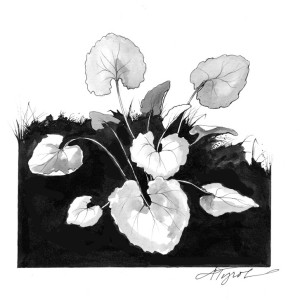
Garlic mustard is trouble. Unlike many other invasive plants, it doesn’t stop at the forest edge. It thrives in partial shade and so has no trouble growing in forest understories.
It can grow densely, crowding out other plants. In the forest, the plants it crowds out include trillium, jack-in-the-pulpit, and our beautiful, often vulnerable, native orchids.
Garlic mustard (Alliaria petiolata) also loves lime, which enables it to aggressively invade lime-rich rare habitats such as calcareous riverside seeps found in a few places along the Connecticut River. The delicate species found in these areas include the plant with the best plant name ever: grass-of-Parnassus, and the aptly named showy orchis which is a two-toned, magenta-and-white beauty.
Garlic mustard also does a number on two butterfly species. The mustard white butterfly and the West Virginia white butterfly (closely related to one another) sometimes mistakenly lay their eggs on garlic mustard instead of native mustards. The results are disastrous. The eggs hatch, but the caterpillars die before they can form a chrysalis.
The rare West Virginia white normally lays its eggs only on toothworts. It is not that toothworts and garlic mustard look alike. (Although both have four-petaled flowers, garlic mustard’s are tiny and white.) Garlic mustard gives off the same chemical that the West Virginia white uses to locate toothwort plants.
For years, garlic mustard was on the “least wanted” list of land managers in southern New England. But lately, garlic mustard has been moving into Vermont and New Hampshire in greater numbers. Bob Popp, a botanist with the State of Vermont, says it’s mostly found in Vermont’s southern four counties, especially near rivers and streams. In New Hampshire, it’s been found in Westmoreland, Manchester, Plainfield, and Hanover.
This is a time of year to keep an eye out for the plant. Its first-year basal rosette, or circle of leaves, stays green throughout the winter. (Garlic mustard is native to northern Europe, so it handles cold well.) It’s not the only green basal rosette you’ll see this time of year, and it’s not the only basal rosette you’ll see with kidney-shaped, scalloped leaves (violets, white avens, and other mustard species look similar). But the fact that it is green now, and not much else is, helps narrow the possibilities.
In winter, look for the distinctive S-shaped bend at the top of the root. In spring, the leaves’ distinctive garlic odor when crushed gives it away.
There are many ways to get rid of this pesky plant. The goal is to stop the plant from setting seed. Unlike many invasive plants, garlic mustard only spreads through seeds.
Hand-pulling is the best choice, and the only choice when rare plants are nearby. But garlic mustard can take over large areas. In those cases, cutting, with a string trimmer or a lawn mower, can work, especially if you cut again and again before the plant sets seed. Herbicide is another option. Garlic mustard grows throughout the winter on warm, snow-free days. Because of this, herbicide can be applied in late fall, winter, or early spring when other, desirable plants are dormant.
According to a report by The Nature Conservancy, the search for a biological control of garlic mustard is focused on five weevils. The question is whether these insects will leave our native mustards alone and only go after garlic mustard.
There is one other way to get rid of garlic mustard, and that is to eat it ourselves. This is not as gruesome as it first sounds. Garlic mustard is used as an herb in England, and it may have been first brought to this continent to be eaten.
Bruce Kennedy, chef for the Manchester site of the Bennington County Meals on Wheels/ Senior Meals Program, came up with this tasty recipe for garlic-mustard pesto for a “meet and eat” program on invasive plants recently. Kennedy notes that young spring leaves are best for the recipe. The plant loses its garlic odor (and taste) as it ages.
Chef Kennedy’s Garlic Mustard Pesto
1 cup garlic mustard leaves
1 garlic clove
2 tablespoons pine nuts
Sea salt (a pinch or two and adjust to taste)
1/2 cup olive oil
4 tablespoons Parmesan cheese, freshly grated
Place garlic mustard, garlic, salt, and pine nuts in a food processor and finely chop. With food processor running, add olive oil in a thin stream. Scrape the sides of the bowl to mix ingredients. Continue to blend until smooth. Add Parmesan cheese and blend using the pulse feature briefly.
Whatever you do, don’t plant the stuff just to eat it. Garlic mustard crowds out rare plants and deceives rare butterflies. There is plenty of it to be had, and plenty of landowners happy to have your help pulling it up.

